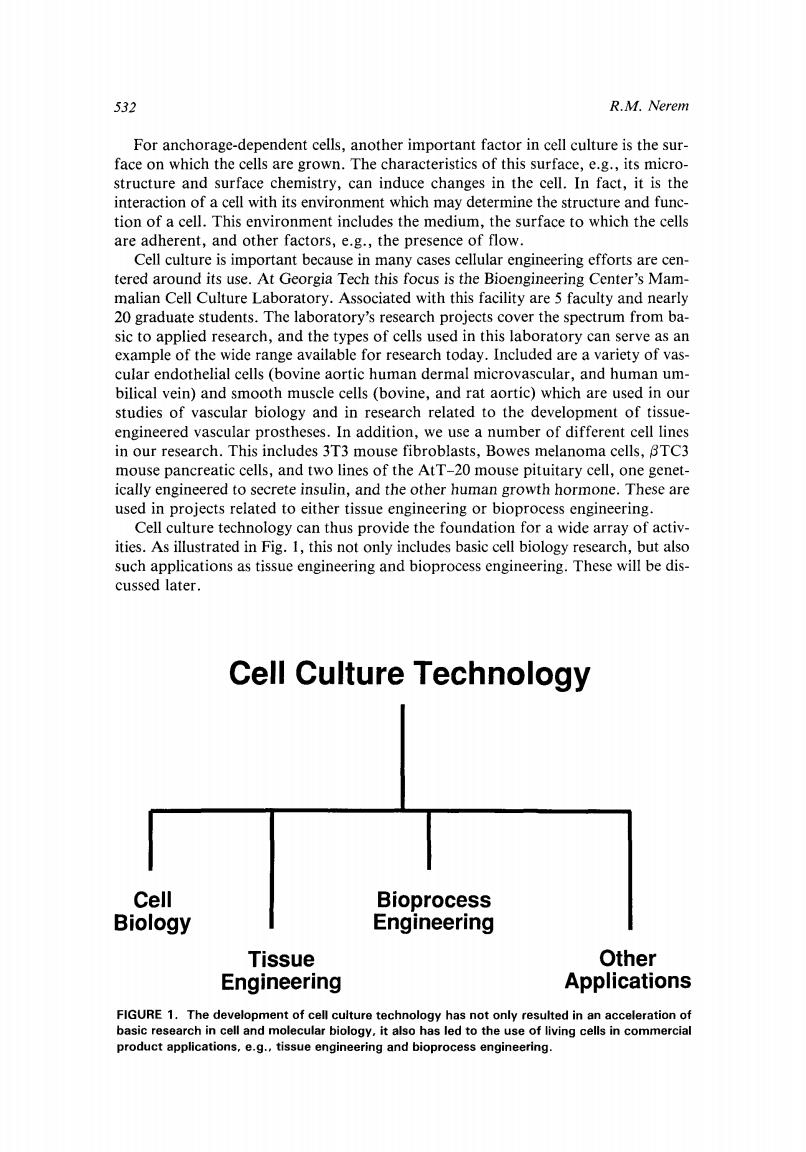正在加载图片...

532 R.M.Nerem For anchorage-dependent cells,another important factor in cell culture is the sur- face on which the cells are grown.The characteristics of this surface,e.g.,its micro- structure and surface chemistry,can induce changes in the cell.In fact,it is the interaction of a cell with its environment which may determine the structure and func- tion of a cell.This environment includes the medium,the surface to which the cells are adherent,and other factors,e.g.,the presence of flow. Cell culture is important because in many cases cellular engineering efforts are cen- tered around its use.At Georgia Tech this focus is the Bioengineering Center's Mam- malian Cell Culture Laboratory.Associated with this facility are 5 faculty and nearly 20 graduate students.The laboratory's research projects cover the spectrum from ba- sic to applied research,and the types of cells used in this laboratory can serve as an example of the wide range available for research today.Included are a variety of vas- cular endothelial cells (bovine aortic human dermal microvascular,and human um- bilical vein)and smooth muscle cells (bovine,and rat aortic)which are used in our studies of vascular biology and in research related to the development of tissue- engineered vascular prostheses.In addition,we use a number of different cell lines in our research.This includes 3T3 mouse fibroblasts,Bowes melanoma cells,BTC3 mouse pancreatic cells,and two lines of the AtT-20 mouse pituitary cell,one genet- ically engineered to secrete insulin,and the other human growth hormone.These are used in projects related to either tissue engineering or bioprocess engineering. Cell culture technology can thus provide the foundation for a wide array of activ- ities.As illustrated in Fig.1,this not only includes basic cell biology research,but also such applications as tissue engineering and bioprocess engineering.These will be dis- cussed later. Cell Culture Technology Cell Bioprocess Biology Engineering Tissue Other Engineering Applications FIGURE 1.The development of cell culture technology has not only resulted in an acceleration of basic research in cell and molecular biology,it also has led to the use of living cells in commercial product applications,e.g.,tissue engineering and bioprocess engineering.532 R.M. Nerem For anchorage-dependent cells, another important factor in cell culture is the surface on which the cells are grown. The characteristics of this surface, e.g., its microstructure and surface chemistry, can induce changes in the cell. In fact, it is the interaction of a cell with its environment which may determine the structure and function of a cell. This environment includes the medium, the surface to which the cells are adherent, and other factors, e.g., the presence of flow. Cell culture is important because in many cases cellular engineering efforts are centered around its use. At Georgia Tech this focus is the Bioengineering Center's Mammalian Cell Culture Laboratory. Associated with this facility are 5 faculty and nearly 20 graduate students. The laboratory's research projects cover the spectrum from basic to applied research, and the types of cells used in this laboratory can serve as an example of the wide range available for research today. Included are a variety of vascular endothelial cells (bovine aortic human dermal microvascular, and human umbilical vein) and smooth muscle cells (bovine, and rat aortic) which are used in our studies of vascular biology and in research related to the development of tissueengineered vascular prostheses. In addition, we use a number of different cell lines in our research. This includes 3T3 mouse fibroblasts, Bowes melanoma cells, ~3TC3 mouse pancreatic cells, and two lines of the ART-20 mouse pituitary cell, one genetically engineered to secrete insulin, and the other human growth hormone. These are used in projects related to either tissue engineering or bioprocess engineering. Cell culture technology can thus provide the foundation for a wide array of activities. As illustrated in Fig. 1, this not only includes basic cell biology research, but also such applications as tissue engineering and bioprocess engineering. These will be discussed later. Cell Culture Technology Cell Biology Bioprocess Engineering Tissue Engineering Other Applications FIGURE 1. The development of cell culture technology has not only resulted in an acceleration of basic research in cell and molecular biology, it also has led to the use of living cells in commercial product applications, e.g., tissue engineering and bioprocess engineering